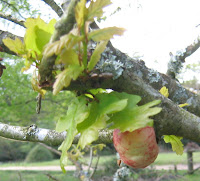
First day of May and the leaves are getting thicker. I saw my first New Forest foal this morning. Standing awkwardly on it's four legs, with the legs spread out slightly wider at the bottom. They are tall but very thin and narrow. Didn't get a pic. Let's hope I find one under the tree.


I didn't photograph the foal but I did find an oak apple on a tree where I have been photographing the buds as they develop. Oak apples are the home of the larvae of gall wasps. In spring the gall wasps lay eggs in the leaf buds of oak and some chemical in the eggs causes the oak to develop these protective "apples" where the larvae live and are fed by the oak. Seems a bit improbable doesn't it? ... but you haven't heard the half of it.
This type of gall wasp (there are about a dozen that live on oak trees) is called Biorhiza Pallida. Alternate generations can fly. The flying ones are sexed and the females mate and lay eggs on the roots of oak trees. These eggs cause another type of gall on the roots. Eventually a flightless all-female generation is born from these galls. This generation all crawl up the trees and lays eggs in the leaf buds that cause the oak apples to grow. How did it all start? Which generation came first? You might well ask but don't expect a sensible answer.
Here is a picture of the wasps, presumably the wingless generation on the first and the winged second. These pics are taken from a German beetle site. The first pic is by B Belman and the second by R Werner
. The site is:
http://www.koleopterologie.de/
I shouldn't really have used them but I thought you would like to see the pics

The galls seem to be all over this particular oak. I suppose lots of wasps laid eggs in its roots. It is less healthy than the main oak. I wonder if galls come more on old oaks like ivy. Or if they actually harm the oak. Anyone know?
PS Oak Apple
day is May 29 to celebrate the restoration of Charles II who had previously hid in an oak tree at some battle or the other. People wore oak apples.













